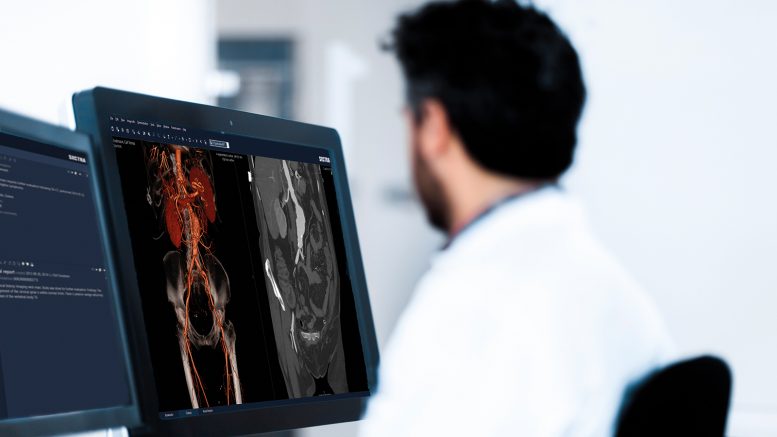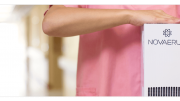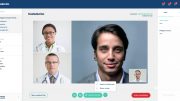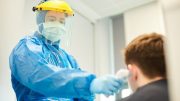Technology for diagnostic imaging typically takes months to deploy into a hospital. As part of a mammoth technology response from Barts Health NHS Trust to make NHS Nightingale Hospital London work, the trust worked tenaciously with its medical imaging provider Sectra to deliver a PACS in three days and create entirely new ways of working for radiographers and radiologists in the COVID-19 field hospital. Barts Health NHS Trust CIO Sarah Jensen and PACS manager Brian Turner explain how it was done.
An unprecedented hospital technology challenge
Barts Health NHS Trust embarked on a monumental technology programme when the trust took charge of creating the very first NHS Nightingale field hospital in London’s Excel conference centre.
The informatics team quickly mobilised alongside other colleagues in the trust to deliver the technology required to make the 4,000 bed NHS Nightingale Hospital London work.
Delivered in an extremely short window of time, the project saw digital patient records in place in five days, the delivery of an entirely new hospital infrastructure, 26km of network cables, more than 500 switches, 4,500 PCs, specialist telephony, imaging modalities, printing for diagnostic labels, wristbands and patient labels for scanning, and an extensive integration of systems.
Staff who had already worked tirelessly for weeks to respond to the urgent COVID-19 needs of Barts Health’s existing five hospitals, were thrust into another intensive operation, working anywhere up to 20 hours a day for five continuous weeks, without weekend breaks to get the job done.
Suppliers responded with equal resolve. In addition to infrastructure partners – three big IT systems suppliers responded immediately to requests for help and started doing work that same day to deliver lab diagnostics, electronic patient records and imaging diagnostics.
This is the story of the latter – how we worked collaboratively to deliver the technology needed for imaging diagnostics in just three days along with newly created pathways and processes – all to ensure clinical teams could deliver the fast and effective care COVID-19 patients required.
The complex imaging requirement
Nightingale needed a unique approach that required Barts Health to work with its imaging technology partner to deliver the picture archiving and communication system (PACS) extremely quickly and to develop entirely new ways of working.
Most hospitals typically manage approximately 20-50 intensive treatment unit beds. Nightingale needed technology capable of supporting imaging for 4,000 ITU beds, spread across a large site, and with the added complication of people using the system to manage a highly infectious and deadly disease.
Time was of the essence. Most PACS deployments take several months. We had a couple of days. A hospital would ordinarily have time to train staff and familiarise them with the system. We had no staff to train at first, and training in a conventional way seemed impossible.
But we did have things in our favour: we were treating a single condition for which the majority of patients would only require a mobile chest x-ray. And there were no appointments to manage.
That certainly didn’t mean the challenge was anything other than daunting, especially in an environment where staff are mobile and don’t have access to tools to book patients in. We asked the question: Is there a way to get the worklist on the mobile machine populated as soon as the exams are requested? This is not normal workflow. Sectra had that up and running in a couple of hours.
Creating a field hospital workflow
We came up with a new field hospital workflow, eliminating standard steps and processes – all the things that could go wrong.
In a standard radiology workflow requests are created in your order comms system. Requests are then sent to the radiology information system, or RIS, which receives requests and handles departmental workflow.
Scans would then be booked in, with exams selected from a modality worklist and sent to the PACS. The radiographer then goes back to the RIS to confirm what they have performed, and enters radiation dose details. Only at that point is the status updated to complete.
That’s fine in an ordinary setting. But in a setting with potentially 4,000 patients we needed to streamline the process significantly to prevent staff becoming overwhelmed.
Eliminating RIS
Removing the RIS altogether from the perspective of the professionals carrying out examinations was the biggest win.
Requests for exams were still generated through the EPR, but then immediately appeared on the imaging modality worklist without staff having to book the exam into RIS.
We automated a great deal, meaning staff spent less time entering details. When requesting in the order comms system, all that staff entered was the reason they needed the exam. Everything else was pulled from the EPR. Ward information allowed the radiographer to find the patient without the RIS.
Automatic forwarding of DICOM structured reporting dose objects to the system used to track radiation exposure for patients, also removed the need for radiographers to manually manage dosage. And eliminating the RIS eliminated the training need. So long as staff knew how to take an x-ray, they could do their job.
Removing the RIS definitely helped speed things along and was very popular with radiographers. Considering staff spent time donning PPE before x-rays could be captured, our average turnaround time was 45 minutes for a chest x-ray to be completed and a further 45 minutes for the report. The whole process took just an hour and half – significantly faster than our six-hour turnaround target.
Probably more impressive still is that the total number of missing RIS (misfiled imaging) during the time Nightingale was in operation was zero.
Solving the imaging communication challenge
NHS Nightingale London became a huge field hospital. It could easily take 20 minutes just to walk from one end to another. Added to this, staff had to operate wearing PPE, and had to navigate ‘dirty’ areas. This posed significant communication challenges, something we were able to use the PACS to start to overcome.
We removed workflow stages for people under pressure in a challenging physical environment, where even using a phone was not easy. Mechanisms in the PACS became invaluable.
A chat window enabled radiologists and clinicians to send messages and for people delivering care to talk directly with the person who produced the report.
An information panel equipped staff with user guides, maps, and a phone directory.
Urgent prioritisation, lessons post-COVID
Critical results were managed in a new way. In normal circumstances this involves securely emailing a referring clinician. NHS Nightingale needed something more robust. Sectra very quickly adapted the system allowing radiologists to easily indicate critical findings requiring urgent action. That automatically triggered an email to a ward group and placed a flag in the worklist. Straight away everyone on the ward could see there was a critical result.
In Nightingale things could become more urgent very quickly. A button was created to allow people to escalate or descale an examination very quickly. It meant patients could be prioritised for all manner of different reasons – whether that’s potential turnaround time breaches, or clinical priorities.
Going forward this escalation approach is likely to be of great value to workflow prioritisation post-COVID, outside of Nightingale, offering the potential for our other hospitals to better manage imaging for cancer referrals and imaging requests from other specialities.
Conclusions
The flexibility of the PACS enabled us to create a very efficient workflow with minimum training and maximum efficiency. This was significantly aided by the agile response of all involved, including our industry partner that committed significant resource without charge to support our needs.
People would come to us with requests, and we could reply ‘yes, we can do that’. We were able to do things people would not think were possible. We never got to test with 3,500 to 4,000 patients, but if it had, our new imaging set up would have held up.





